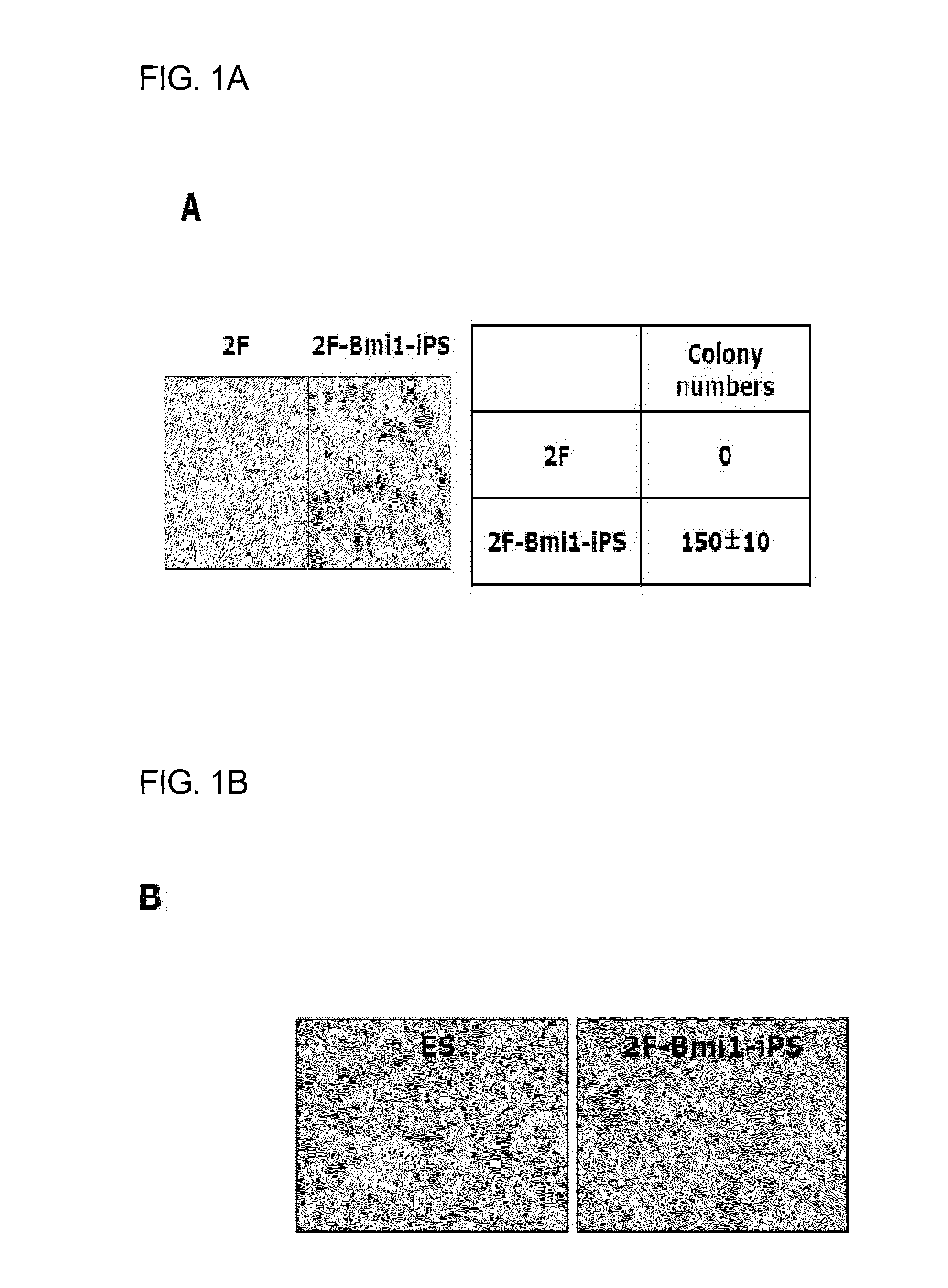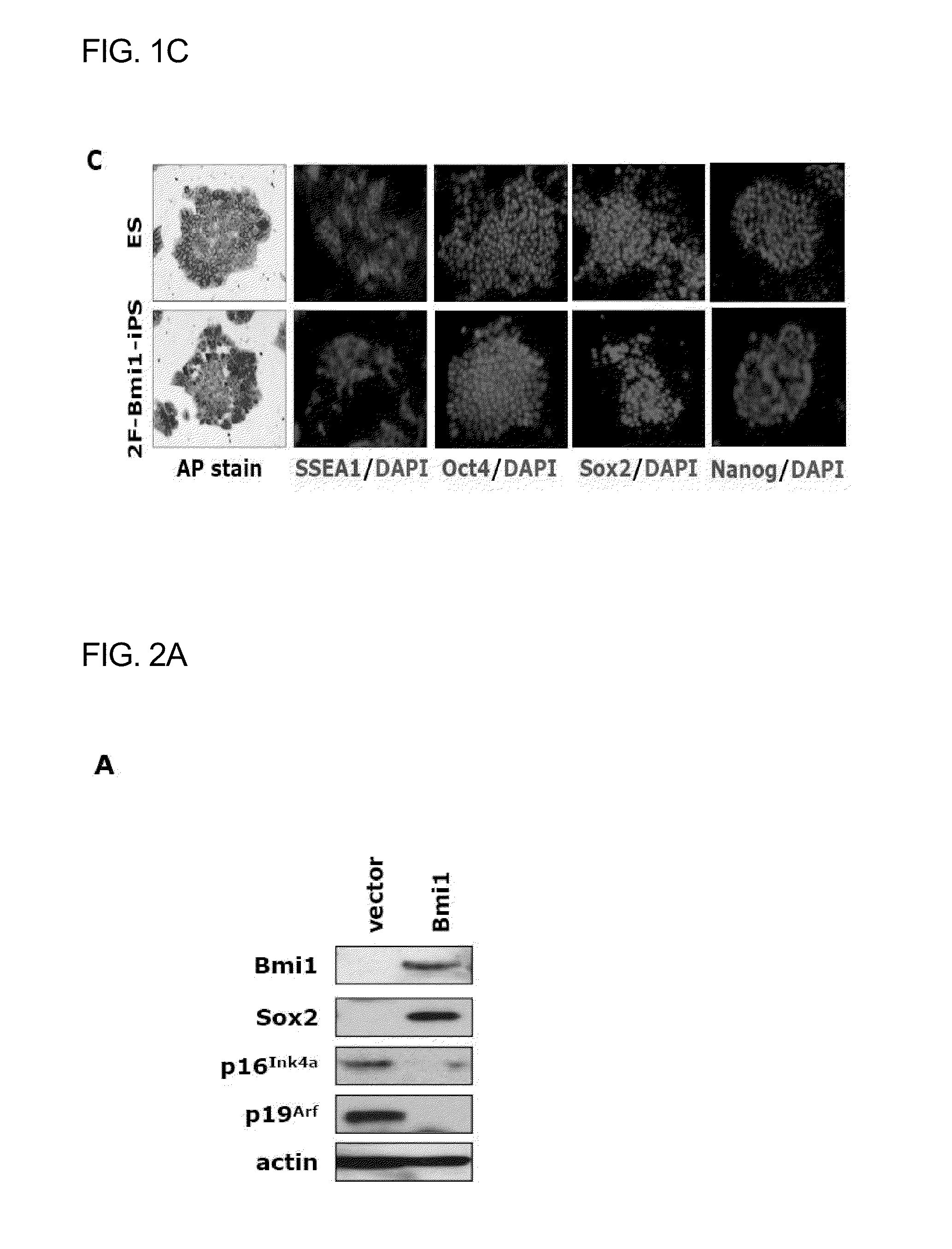COMPOSITION FOR REPROGRAMMING SOMATIC CELLS TO GENERATE INDUCED PLURIPOTENT STEM CELLS, COMPRISING Oct4 IN COMBINATION WITH Bmi1 OR ITS UPSTREAM REGULATOR, AND METHOD FOR GENERATING INDUCED PLURIPOTENT STEM CELLS USING THE SAME
a technology of induced pluripotent stem cells and somatic cells, which is applied in the direction of genetically modified cells, extracellular fluid disorders, metabolic disorders, etc., can solve the problems of difficult proliferation of stem cells in practice, difficult to isolate a large number of cells from patients, and obstacles to overcome in clinical use of embryonic stem cells, like adult stem cells, to achieve the effect of reducing the number of genes
- Summary
- Abstract
- Description
- Claims
- Application Information
AI Technical Summary
Benefits of technology
Problems solved by technology
Method used
Image
Examples
example 1
Culture of Mouse Embryonic Fibroblasts and Introduction of Oct4 and Bmi1 Genes Therein
[0136]Mouse embryonic fibroblasts were employed to generate embryonic stem cell-like cells. Embryos were taken from CF1 strain mice on embryonic day 13.5. Cells were cultured in DMEM (high glucose, w / o sodium pyruvate) supplemented with 10% FBS (Fetal bovine serum), 0.1 mM non-essential amino acid, 1% penicillin / streptomycin and 0.1 mM β-mercaptoethanol in tissue culture flasks, after which fibroblasts at the 3rd passage were seeded at a density of 2×105 cells / well into 6-well plates.
[0137]For use in gene transfer, retrovirus particles were prepared from the PT67 packaging cell line. In this regard, a pBabe puro Bmi1 (from Dr. G. P. Dimri, Evanston Northwestern Healthcare Research Institute, Feinberg School of Medicine, Northwestern University, Evanston, Ill. 60201, USA), constructed by inserting a human Bmi1 gene (NCBI accession No. L13689) into a pBabe puro vector and a pBabe neo Oct4 vector, con...
example 2
Reprogramming by Introduction of Oct4, Sox2 and Bmi1 Genes
[0139]Reprogramming was induced by introducing into mouse embryonic fibroblasts two genes Oct4 and Sox2 (2F) or three genes Oct4, Sox2 and Bmi1 (2F-Bmi1) and the results were compared.
[0140]After the retroviral transduction of Example 1 was performed, the cells were induced to undergo reprogramming under the culture conditions of mouse embryonic stem cells. To this end, the cells were subcultured in high-glucose DMEM supplemented with 15% FBS (Fetal bovine serum), 0.1 mM nonessential amino acid, 1% penicillin / streptomycin, 0.1 mM β-mercaptoethanol and 1000 unit / ml mouse LIF (leukemia inhibitory factor) in the presence of a feeder cell, with a passage every 2-3 days.
[0141]FIG. 1 shows reprogramming efficiencies upon introduction of Oct4 and Sox2 genes, and Oct4, Sox2 and Bmi1 genes. As seen in FIG. 1A, a far greater number of AP-positive colonies were generated from cells infected with retrovirus encoding Bmi1 gene plus two fa...
example 3
Reprogramming of Mouse Embryonic Fibroblasts into Neural Stem Cell-Like Cells by Bmi1 Gene Introduction
[0142]When retroviral transduction was performed on mouse embryonic fibroblasts as in Example 1, the Bmi1 target genes p16Ink4a and p19arf were found to decrease in expression level as measured by a Western blotting assay, while Sox2 expression was increased (FIG. 2A).
[0143]When the Bmi1-transduced cells were cultured in a medium adapted for neural stem cells, they were observed to aggregate and change morphology to that of neurospheres (FIG. 2B). These cells were analyzed by AP staining and immunochemistry for Nestin and Sox2, markers typical of neural stem cells. Also, the Bmi1-transduced cells differentiated, like neural stem cells, into astrocytes, neurons and oligodendrocytes as measured by immunochemical staining for GFAP, Tuj1 and O4, which are respective markers typical thereof. Therefore, the introduction of Bmi1 gene induced mouse embryonic fibroblasts to undergo a reprog...
PUM
 Login to View More
Login to View More Abstract
Description
Claims
Application Information
 Login to View More
Login to View More - R&D
- Intellectual Property
- Life Sciences
- Materials
- Tech Scout
- Unparalleled Data Quality
- Higher Quality Content
- 60% Fewer Hallucinations
Browse by: Latest US Patents, China's latest patents, Technical Efficacy Thesaurus, Application Domain, Technology Topic, Popular Technical Reports.
© 2025 PatSnap. All rights reserved.Legal|Privacy policy|Modern Slavery Act Transparency Statement|Sitemap|About US| Contact US: help@patsnap.com



